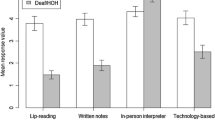Abstract
OBJECTIVE: To test the hypothesis that profoundly deaf persons would have better preventive care compliance and improved physician communication if enrolled in a primary care program providing American Sign Language (ASL) interpreters.
DESIGN: A case-cohort community-based study. The authors had ASL-fluent research assistants interview 90 randomly selected patients (the cases) enrolled in a unique primary care program for the deaf (Deaf Services Program), which provided full-tune ASL interpreters and subsidized health care costs for some patients. Eighty-five deaf controls were friends of the cases drawn from the community.
RESULTS: The cases were poorer and less often married than were the controls, but other baseline characteristics were similar. The cases were more likely (p<0.05) to report receiving within the preceding three years Pap tests (90% vs 72%), mammography (86% vs 53%), and rectal examinations (72% vs 25%), but not breast examinations (76% vs 71%, p=0.7). The cases were more likely than the controls to report receiving counseling in ASL for psychiatric and substance abuse problems (49% vs 5%, p<0.001). Although only 18% of the controls were fluent in written English, 67% of them used written notes to communicate with their physicians. Twenty percent of the controls used ASL interpreters compared with 84% of the cases (p<0.001). More cases than controls were moderately or extremely satisfied with communication with their physicians (92% vs 42%, p<0.001).
CONCLUSION: Deaf persons enrolled in a primary care program that included full-time interpreters were more likely to use ASL, were more satisfied with physician communications, and had improved preventive care outcomes.
Similar content being viewed by others
References
Schein JD, Delk MT. The deaf population of the United States. Silver Spring, MD: National Association of the Deaf. 1974.
Reisman G. Medical interpreting for hearing-impaired patients. JAMA. 1977;237:2397–8.
Silverman SR. Rehabilitative audiology. In: Paparella MM, Shumrick DA. Gluckman JL, Meyerhoff WL (eds). Otolaryngology. Philadelphia: W. B. Saunders. 1991;1005–15.
Schein J. Delk M. Survey of health care for deaf people. Deaf Am. 1980;32:5–27.
Schlesselman J. Case—Control Studies. New York: Oxford Press. 1982;77.
Wachman S. McLaughlin JK. Silverman DT, Mandel JS. Selection of controls in case-control studies, I: Principles. Am J Epidemiol. 1992;135:1019–28.
Ronco G. Segnan N, Ponti A. Who has Pap tests? Variables associated with the use of Pap test in the absence of screening programmes. Int J Epidemiol. 1991;20:349–53.
Centers for Disease Control. Use of mammography for breast cancer screening—Rhode Island. 1987. MMWR. 1988;7:357–61.
National Cancer Institute Breast Cancer Screening Consortium. Screening mammography: a missed clinical opportunity? JAMA. 1990;264:54–8.
Lass L, Franklin R. Bertrand W, Baker J. Health knowledge, attitudes and practices of the deaf population in greater New Orleans-a pilot study. Am Ann Deaf. 1978;123:960–7.
Kleinig D. Mohay H. A comparison of the health knowledge of hearing-impaired and hearing high school students. Am Ann Deaf. 1990;134:246–51.
Nemon A. Deaf persons and their doctors. J Rehabil Deaf. 1980;14:19–23.
Americans with Disabilities Act of 1990. 28 CFR 36.102–36.104.
Sawyer J, Earp J, Fletcher R, Daye F. Wynn T. Accuracy of women’s self-report of their last Pap smear. Am J Public Health. 1989;79:1036–7.
Walter S. Clarke E. Hatcher J, Stitt L. A comparison of physician and patient reports of Pap smear histories. J Clin Epidemiol. 1988;41:401–10.
Author information
Authors and Affiliations
Rights and permissions
About this article
Cite this article
MacKinney, T.G., Walters, D., Bird, G.L. et al. Improvements in preventive care and communication for deaf patients. J Gen Intern Med 10, 133–137 (1995). https://doi.org/10.1007/BF02599667
Issue Date:
DOI: https://doi.org/10.1007/BF02599667




